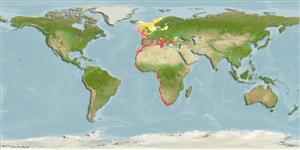Classification / Names
Common names from other countries
Main reference
Size / Weight / Age
Max length : 150 cm TL male/unsexed; (Ref. 247); common length : 55.0 cm TL male/unsexed; (Ref. 26999)
Length at first maturity
Lm ?, range 50 - ? cm
Environment
Marine; bathydemersal; depth range 40 - 777 m (Ref. 56504)
Climate / Range
Deep-water, preferred 26°C (Ref. 107945); 70°N - 37°S, 17°W - 34°E (Ref. 54693)
Distribution
Eastern Atlantic: Bay of Biscay and Mediterranean Sea to Senegal, north to Cornwall, England (apparently as a stray). Compagno et al. (Ref. 5578) reports this species as ranging south to Cape Point, South Africa but Springer 1990 (Ref. 10718) notes Bass et al. 1976 as considering specimens from Walvis Bay distinct from Oxynotus centrina calling attention to the considerably greater distance between dorsal fins in Mediterranean specimens than in specimens taken south of the equator.
Countries | FAO areas | Ecosystems | Occurrences | Introductions
Short description
IUCN Red List Status (Ref. 115185)
Threat to humans
Harmless
Human uses
Fisheries: minor commercial
More information
ReferencesAquacultureAquaculture profileStrainsGeneticsAllele frequenciesHeritabilityDiseasesProcessingMass conversion
Tools
Special reports
Download XML
Internet sources
Estimates of some properties based on models
Phylogenetic diversity index
PD50 = 0.5625 many relatives (e.g. carps) 0.5 - 2.0 few relatives (e.g. lungfishes)
Trophic Level
3.1 ±0.26 se; Based on food items.
Resilience
Very Low, minimum population doubling time more than 14 years (Fec=7)
Vulnerability
Very high vulnerability (80 of 100)
Price category
